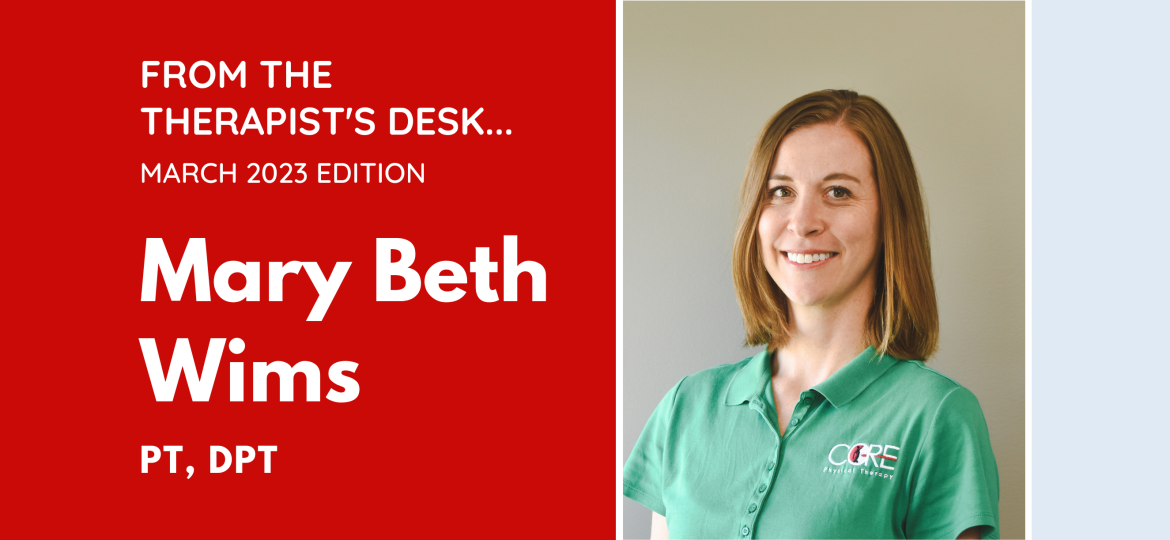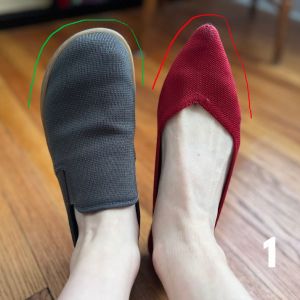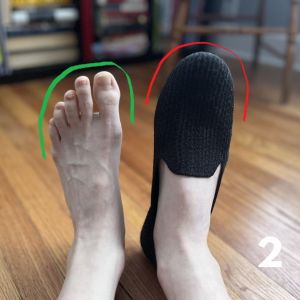
Each month we’ll bring you a note from one of our therapists. It might be something they’re reading, learning or just something they want to share.
This month’s note is from Mary Beth Wims, PT, DPT, Registered Yoga Teacher (RYT-200):
Shoes serve many functions in our modern lives. They protect us from cuts and bruises, keep us warm, prevent disease transmission, and support us while standing, walking, and running. They also offer a way to express our personalities. Something I’ve been learning more about recently is whether the shoes and socks we wear can also negatively impact our foot health, our balance, and even the wear and tear on the other joints in our bodies.
Before I dive in, know that the research on this topic is across the board. I’m going to offer some generalities based on both my own experience and some highlights from what science currently says. If you exercise your Google skills, you will find results on both sides of this debate. Also, this is a very complex topic and can’t be boiled down to black or white answers, which is part of the challenge with medical research. Every patient is different and every situation is unique. Okay, now that I’ve got those disclaimers out of the way, let’s dive in.
The controversy centers around whether typical shoes – shoes with cushion (sometimes a lot of it), a differential between the height of the sole under the heel versus under the forefoot (called heel-to-forefoot differential), and/or narrow toe boxes – change our foot shape and foot muscle activation. Critics of typical shoes contend that a lifetime of wear can decrease our sensory connection with our feet, affect our balance, weaken our muscles, put us at greater risk for conditions like bunions, and alter our gait pattern negatively by changing our foot strike.
Minimalist shoes, in comparison, have a zero-drop heel (no difference in height between the heel and the forefoot), a flexible and thin sole, and a foot-shaped toebox (foot-shaped is different from wide….we’ll get to that later). Proponents of minimalist shoes report that this type of footwear helps us have better sensory connection with the ground, gives us a more natural stride which improves gait mechanics, and give our toes room to spread out, ultimately decreasing foot pain and deformity over time. Minimalist fans also say that our feet get a much better workout when they don’t have all the support and cushions of typical shoes. So worn over time, they argue, these shoes can help our feet get stronger naturally.

Here is an example of how a typical shoe is shaped differently from a minimalist shoe. In the first photo, I’m wearing a minimalist shoe on my left foot. It’s got a much wider and foot-shaped toebox and has a flat and flexible sole. I loved the red shoe on the right, and wore these for a few years at work. They are comfortable and I like how they look. But as I’ve learned more about this topic, I’ve transitioned out of wearing this pair because of concerns about future bunion formation of my big toe (also called hallux valgus). In photo two, I’ve taken off my shoe so you can see my typical foot shape (notice I’ve already got a bunion on the outside of my pinkie toe – that guy is called a Tailor’s bunion). On my right foot is another traditional shoe. This one is definitely wider (way better than the red one!), but you can still see that my foot doesn’t have the room to spread out like it does when I’m wearing the minimalist shoe in photo one.
Even though research is still being done on whether our shoes should have more or less support, and whether or how that impacts our balance and gait pattern, there does seem to be more agreement in one area: wearing shoes with a narrow toe box and a heel, especially in our younger years, can encourage bunion formation later in life. And yes, factors such as genetics are involved here too, so this isn’t a 100% cause and effect situation. You probably know someone who wore heels for years and doesn’t have foot trouble. But, most general wisdom, especially these days, is that we should look for shoes that allow our feet to spread, like they would if we weren’t wearing shoes. I thought the black loafer on my right foot (photo two) was doing just that, because it was “wide”. But in the minimalist shoe, I have even greater freedom of movement.
 I can’t tell you I’ve noticed a huge difference in how my feet feel as I’ve been transitioning to more minimalist shoes versus typical shoes. But I didn’t have foot pain to start with. My interest in making the change was due more to the interesting biomechanics questions that come about in this debate, and because I love learning about the human body. I also have bunion surgery in my family histo
I can’t tell you I’ve noticed a huge difference in how my feet feel as I’ve been transitioning to more minimalist shoes versus typical shoes. But I didn’t have foot pain to start with. My interest in making the change was due more to the interesting biomechanics questions that come about in this debate, and because I love learning about the human body. I also have bunion surgery in my family histo
As far as the differences in force production and gait patterns between wearing typical shoes versus minimalist shoes… there’s still more work to be done and you can probably find podiatrists, physical therapists, and many other healthcare providers on both sides of the discussion. If you are interested in trying a more minimalist model, proceed slowly and with caution. What we as physical therapists see is that injuries often occur when someone makes a drastic change in their activity level before their muscles and joints can become acclimated to the increased demands. If you’ve been wearing highly cushioned shoes while running, or pointed-toe loafers at work like my red ones, don’t hit the ground running (pun intended!) and go for a three-mile jog in your new minimalist shoes, or even spend a full workday wearing them.
A smarter approach is to gradually increase the time you spend in minimalist shoes, or maybe even go barefoot for short bursts of time in your home. Give your feet time to adjust, and to become more flexible and stronger. I had a lot of calf tightness and soreness when I started wearing minimalist walking shoes as my muscles were being loaded differently. It takes time to build strength.
And as always, your unique situation may be different, especially if you have chronic foot pain, surgical history, or need rigid shoes to protect your skin (like those with diabetes might). I’d recommend consulting with a trusted healthcare provider before making any big changes in your footwear choices.
Here are some resources that have helped me in my learning. Enjoy!
Hallux Valgus – Physiopedia (physio-pedia.com)
Effect of Minimalist Footwear on Running Efficiency – PMC (nih.gov)
Running Shoe or Minimalist Shoe? – NASM
